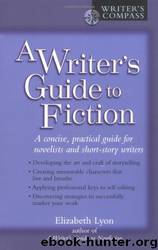A Writer's Guide to Fiction by Elizabeth Lyon

Author:Elizabeth Lyon [Lyon, Elizabeth]
Language: eng
Format: epub, mobi
Published: 2011-04-18T07:00:00+00:00
Life is either a daring adventure or nothing. To keep our faces toward change and behave like free spirits in the presence of fate is strength undefeatable.
Helen Keller
PHYLLIS WHITNEY, THE famous writer with more than one hundred novels to her credit, described her ideal timeline and methods for writing a book as these: two months for research, including filling in characterization worksheets and blocking out her plot; two months for writing the first draft, according to a quota-per-day page count; and two months to revise and rewrite. Six months per novel.
Whether you hope to write novels or short stories, you are more likely to start—and finish—if you follow a plan. As you approach the day when you begin writing, you may notice an increase in a mixture of excitement and trepidation. There is an inverse relationship between preparation and first-draft writing: the longer time spent preparing, the shorter time spent writing. If you've already followed all of the preparation work recommended in this book, you may wonder, "What else is left?"
Up to now, you have addressed the larger issues of mapping out a short story or a novel. But how do you write from chapter to chapter, section to section, or even paragraph to paragraph? If you are writing
a short story, how do you develop continuity, narrative tension, and reader interest from your first word to your last?
You need the "Six Sherpas." The word sherpa refers to Tibetans who guide mountaineers and carry their heavy packs. Your literary sherpas will enable you to write anything, long or short, serious or frivolous, ex perimental or commercial. Everything covered in prior chapters—the five-part structure, Hero's or Heroine's Journey, other whole-story out lines, and characterization development—are indispensable for map ping your work as a whole. These next six elements of craft are indispensable for writing word by word. Here are the Six Sherpas:
• Scenes
• Subtext
• Sequels
• Shortcuts
• Segues
• Set pieces
Scenes and Subtext
A one-word definition for scene is "action." As used in writing fic tion, scene means "events that occur over one period of time at one setting in response to one character's intention." If your writing jumps in time, you have broken the scene. If it jumps to another set ting, you have broken the scene. If you jump from one character's in tentions to another, you have broken the scene.
My preferred definition of a scene is a bit of a cliche in writing circles, but it gets right to the heart of fiction: Scene is conflict. A story arc defines the sweep of events from beginning to end. A char acter arc defines character change and growth over time. And a scene arc defines when an irresistible force meets an unmovable object.
Scenes have a structure that is the microcosm of a whole book's dramatic structure. A point-of-view character communicates an inten tion or goal and acts on it. Opposition to repeated efforts to reach the
goal define the scene arc, resulting in the point-of-view character's success or failure at the end of the scene.
Download
A Writer's Guide to Fiction by Elizabeth Lyon.mobi
This site does not store any files on its server. We only index and link to content provided by other sites. Please contact the content providers to delete copyright contents if any and email us, we'll remove relevant links or contents immediately.
Asking the Right Questions: A Guide to Critical Thinking by M. Neil Browne & Stuart M. Keeley(5635)
Autoboyography by Christina Lauren(5184)
Eat That Frog! by Brian Tracy(4435)
Dialogue by Robert McKee(4321)
Sticky Fingers by Joe Hagan(4101)
Journeys Out of the Body by Robert Monroe(3572)
Annapurna by Maurice Herzog(3423)
Full Circle by Michael Palin(3387)
Schaum's Quick Guide to Writing Great Short Stories by Margaret Lucke(3319)
Elements of Style 2017 by Richard De A'Morelli(3307)
The Art of Dramatic Writing: Its Basis in the Creative Interpretation of Human Motives by Egri Lajos(3015)
Atlas Obscura by Joshua Foer(2899)
The Diviners by Libba Bray(2887)
In Patagonia by Bruce Chatwin(2876)
Why I Write by George Orwell(2874)
The Fight by Norman Mailer(2848)
The Mental Game of Writing: How to Overcome Obstacles, Stay Creative and Productive, and Free Your Mind for Success by James Scott Bell(2845)
Venice by Jan Morris(2526)
The Elements of Style by William Strunk and E. B. White(2440)
